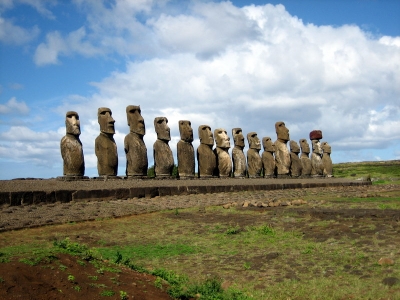
Easter Island is famous for its stone statues of human figures, known as moai (meaning “statue”). The island is known to its inhabitants as Rapa Nui. The moai were probably carved to commemorate important ancestors and were made from around 1000 C.E. until the second half of the seventeenth century. Over a few hundred years the inhabitants of this remote island quarried, carved and erected around 887 moai. The size and complexity of the moai increased over time, and it is believed that Hoa Hakananai’a (below) dates to around 1200 C.E. It is one of only fourteen moai made from basalt, the rest are carved from the island’s softer volcanic tuff. With the adoption of Christianity in the 1860s, the remaining standing moai were toppled.
The production and transportation of the more than 900 statues is considered a remarkable creative and physical feat. The tallest mo?ai erected, called Paro, was almost 10 metres (33 ft) high and weighed 82 tonnes (80.7 tons). The heaviest mo?ai erected was a shorter but squatter mo?ai at Ahu Tongariki, weighing 86 tonnes (84.6 tons). One unfinished sculpture, if completed, would have been approximately 21 m (69 ft) tall, with a weight of about 145–165 tons. The mo?ai were toppled in the late 18th and early 19th centuries, possibly as a result of European contact or internecine tribal wars.
Picture Credit : Google

